Abstract
The use of crop residues is increasing across farming systems as part of climate change mitigation efforts and agricultural management practices to improve soil health. Hemp residues offer valuable potential in these efforts due to their rich nutrient composition. However, the complex chemical composition of hemp residue could pose a significant challenge by slowing the decomposition rate if not adequately managed. The aim of this study is to evaluate the influence of different timings of hemp residue incorporation, soil tillage practices, and mode of application on the rate of mineralization and soil chemical parameters. A complete randomized design field trial was conducted on hemp (Cannabis sativa L.) residue incorporation across different seasonal periods and modes of application. The results showed that the fastest mineralization occurred when hemp residue was incorporated in autumn, while the slowest mineralization was observed when the residue was left on the surface of the soil as mulch. The application of hemp residues over three years led to a slight increase in soil pH from an initial value of 4.9; however, this change was not statistically significant. Similarly, nitrogen content did not change significantly between the different periods after applying hemp residues. In contrast, hemp residues contributed to an increase in soil carbon content. Overall, this study emphasizes the need to optimize hemp residue management to maximize its benefits for enhancing soil chemical properties and promoting sustainable agriculture.
1. Introduction
Hemp (Cannabis sativa L.) is a versatile crop cultivated globally for its valuable fiber, nutrient-rich seeds, essential oils, and bioenergy potential [1,2]. In recent years, hemp cultivation has gained renewed interest in response to global efforts to combat climate change and provide sustainable alternatives to agricultural practices that negatively impact soil health. Due to its rapid biomass accumulation, deep root system, and low input requirements, hemp is increasingly recognized as a promising energy crop and a viable alternative for high land use efficiency [3,4,5]. Consequently, hemp cultivation is expanding across various geographical regions, driven by its potential to contribute to bioeconomy development and climate-resilient agriculture.
Hemp cultivation may contribute to solving many problems. As soil degradation problems are increasingly observed across Europe, new agricultural management strategies, such as incorporating crop residues, reduced tillage, organic fertilization, and cover cropping, are promoted to enhance soil health [6,7,8,9]. Their adoption is critical for achieving climate change resilience and long-term sustainability in European agroecosystems. One of the proposed solutions is the introduction of plant residue with varieties of different qualities back into the soil [10,11,12,13]. Returning straw or other plant residues to the soil is a beneficial agricultural practice that manages and increases the conservation of soil quality and crop productivity [14]. An additional benefit is the sustainable utilization of agricultural wastes to reduce environmental pollutants while offering economic and agricultural benefits [15,16]. However, research remains limited on how non-food crops with high lignocellulosic content, such as hemp residues, affect soil chemical properties and subsequently influence crop yields.
Intensive cultivation leads to the loss of organic matter in the soil [17,18]. In contrast, there is growing evidence that conservation agriculture can play an important role in increasing soil organic carbon stocks [18,19,20]. Tillage mixes the organic matter on the soil surface into the plowed layer, directly increasing the amount of organic carbon in the deeper soil layers, especially when combined with crop residues [19]. Furthermore, tillage promotes extensive root growth by loosening the soil and enhancing nutrient availability in deeper layers. This improves water infiltration into the subsoil and increases crop productivity [21,22]. Incorporating plant residues and straw into the soil facilitates nutrient transformation, replenishing the soil’s nutrient supply and boosting metabolism. This practice, widely recognized in sustainable agriculture, improves soil fertility, supports higher crop productivity, and significantly influences the biogeochemical dynamics of key elements such as carbon, nitrogen, phosphorus, and potassium [23].
The microbial transformation of plant residues into soil organic matter (SOM) is an ongoing process driven by key mechanisms such as mineralization, recycling, microbial necromass, and residue accumulation [24]. Specifically, the microbiological mineralization of crop residues in soil, which provides nutrients to plants, is influenced by factors such as the chemical composition of the residues, seasonal changes, soil moisture content, soil texture, and the presence of specific microbiomes [25,26]. However, the high lignocellulosic content of hemp straw presents a challenge [27,28], as it breaks down slowly. The exposure to favorable conditions, such as increased pH, optimal soil moisture, nitrogen addition, enhanced microbial activity, and aeration through tillage, can, however, enhance the breakdown of crop residues with such complex compounds [26,28,29,30].
Similarly, straw incorporation also improves soil pH [31,32]. The use of plant residues and straw increased the pH of the soil, thereby creating favorable conditions for microbial activity, which resulted in the transformation of carbon into organic carbon [33]. Crop residues are vital in regulating soil nutrients, such as nitrogen, phosphorus, and potassium, with inorganic nitrogen being particularly important as a primary nutrient absorbed by plants. Through mineralization, residues or straw release inorganic nitrogen, enhancing its availability for plant uptake [34]. Furthermore, the incorporation of these residues not only promotes nutrient cycling but also serves as an effective method for managing organic waste, contributing to the reduction of phosphorus and potassium deficiencies in agricultural soils [35,36]. Thus, returning plant residues or straw to the soil can increase the amount of organic carbon, stimulate the release of inorganic nitrogen, and contribute to preserving phosphorus and potassium. However, there is still a lack of information about using alternative biomass, such as hemp straw with high fiber and lignocellulose content, as soil additives. Thus, this study aimed to evaluate the decomposition rate of hemp residues using appropriate embedding techniques. It was hypothesized that different timings and modes of hemp residue application would affect the rate of residue mineralization in the soil.
2. Materials and Methods
2.1. Experimental Design
The experimental study was carried out in the experimental fields of the Lithuania Research Centre for Agriculture and Forestry (55°40′ N, 23°87′ E) for two growing seasons (2021 and 2022). The experiment was set up at the start with the hemp (Cannabis sativa L.) cultivar “Felina 32” (Paris, French). The sowing rate was 35 kg·ha−1. Seeds were sown on 28 May 2021 and 24 May 2022, respectively. The cultivation period was from May to August for two (2) consecutive years in two different fields. The experiment was replicated over two growing seasons under uniform soil conditions to minimize the impact of annual weather variability and ensure consistent trends.
The field experiment was established with four treatments in four replicates (Figure 1), each tested for 9 months and repeated for 2 years. Each treatment plot was 30 m2 (3 m × 10 m). The experimental treatments were as follows: control without hemp residues, hemp residues plowed in autumn, hemp residues plowed in early spring, and hemp residues left on the soil without plowing.
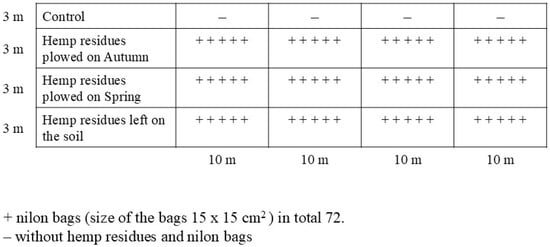
Figure 1.
The experimental scheme of the field.
Simultaneously, litter bag experiments were conducted in the same experimental field to determine the mineralization rate of hemp residues in the soil. For this, 72 litter bags (15 cm × 15 cm, 0.1 mm mesh size), each containing 15 g of dried hemp residues, were prepared and placed across the three treatment plots that received hemp residue, excluding the control treatment. The hemp residues were chopped into 1–2 cm pieces before being placed in the bags to ensure uniform decomposition and facilitate mineralization across treatments. The litter bags were either plowed into the soil at a 20–25 cm depth or left on the soil surface, depending on the treatments. One litter bag from each treatment was retrieved monthly and weighed to assess the mineralization rate. This litter bag experiment was conducted for 10 months, and during the winter period, when the soil was frozen, the bags were not collected. The chemical properties of the hemp residues are shown in Table 1.

Table 1.
Chemical properties of the hemp residue.
2.2. Soil Physicochemical Properties Analysis
The experimental fields were characterized by sandy loam soil, classified as Endocalcari–Epihypogleyic Cambisol, with a texture comprising 58.8% sand, 37.8% silt, and 3.9% clay. Soil samples were collected at the beginning of the experiment from a depth of 0–25 cm in triplicate from each treatment plot. The carbon and nitrogen content of each composite soil sample was measured using the CNS Elemental combustion system equipment (Costech Instruments, Pioltello MI, Italy). A 10 g portion of each sample was weighed into an alov capsule, which was then folded and placed into the CNS equipment for analysis. The soil pH was determined in a 1:5 (vol−1) soil suspension in the 1 M KCl solution and subsequently measured in a pH meter (XS Instruments, Carpi MO, Italy). The soil chemical analysis was conducted on samples collected at the beginning of the field trial, after drying them at room temperature. Mobile K2O and P2O5 concentrations were determined using the ammonium lactate–acetic acid extraction method (Egner, Riehm, and Domingo—A-L method). The initial soil chemical analysis conducted at the start of the 2021–2023 period showed concentrations of 82.66 mg kg−1 for P2O5, 163 mg kg−1 for K2O, and 0.92% for organic carbon. In comparison, the 2022–2024 analysis showed 107.67 mg kg−1 of P2O5, 97.75 mg kg−1 of K2O, and 1.52% organic carbon. The same analyses were repeated after the two periods of the experiment, and changes in soil chemical composition are presented in the results section. Soil texture was characterized before the trial using the pipette method (Eijkelkamp equipment, Royal Eijkelkamp, Giesbeek, The Netherlands).
2.3. Meteorological Conditions
Figure 2 presents the meteorological conditions from January 2021 to December 2023. The average temperature of the decomposition seasons (October 2021 to October 2023) was higher at 8.33 °C compared to the 100-year long-term (1924–2023) average (6.55 °C) for these periods. In contrast, the long-term precipitation average was 47.5 mm, slightly higher than the mean precipitation recorded during the experimental period, which was 46.3 mm. The total precipitation recorded in 2021–2022 was higher and reached 150 mm and 151.1 mm in the years 2021 and 2022, respectively. In 2023, it was extremely dry during the year, specifically during the experimental period. The average precipitation in the 2023 summer (Jun–Aug) was 46.75 mm, according to data available from the Lithuanian Hydrometeorological Service-Dotnuva data under the Ministry of Environment, http://www.meteo.lt/, accessed on 22 February 2024.
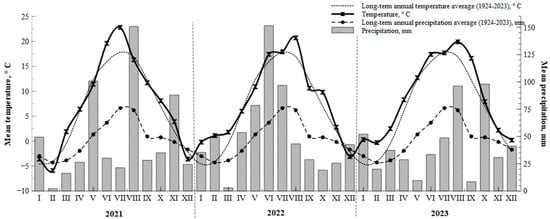
Figure 2.
Meteorological conditions during the experiment (2021–2023) and the 100-year-long-term average.
2.4. Statistical Analyses
The observed data were statistically processed using SAS Enterprise Guide 7.1. The Tukey HSD test was applied to determine significant differences between means at an alpha level of 0.05. Lowercase letters that differ denote significant differences at p < 0.05.
3. Results and Discussion
3.1. Hemp Biomass and Stem Content
In considering the 2021 experimental results, the total biomass of hemp was 19 t ha−1 (calculated on a dry matter basis), and the biomass of the residues that were returned to the soil was 8.08 t ha−1, which constituted 42% of the total biomass yield (Figure 3). This aligns with previous findings, highlighting that fiber hemp biomass is affected by environmental conditions, fertilization levels, sowing time, plant density, and genotypes [37,38,39,40]. Campiglia et al. found that as the plant density increases, so does the amount of biomass [38], and as the biomass increases, so does the number of residues that will need to be disposed of later. Similar results were reported by other researchers, such as Schluttenhofen and Yuan, who reported 14 t ha−1 (dry matter) and 10 t ha−1 of residues [41]. However, the differences in biomass and residues between this experiment and those of these two scientists were not very large.
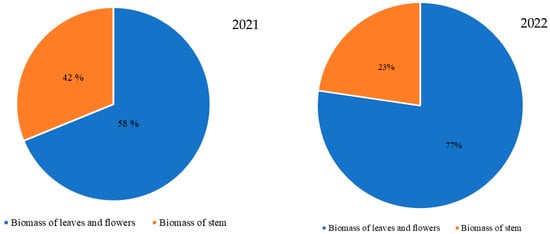
Figure 3.
Hemp biomass produced and hemp biomass applied residues for the years 2021 and 2022.
The results from 2022 showed that the biomass of hemp was 14.01 t ha−1 (calculated on a dry matter basis), while the residues returned to the soil were 6.32 t·ha−1 (calculated on a dry matter basis), which is 23% of the total biomass yield.
The difference in biomass yield between the years 2021 and 2022 could be affected by different weather conditions during the growing season. This is reflected in the warm and favorable precipitation conditions observed in 2021 (Figure 2), conditions known to promote biomass accumulation in hemp [42,43].
3.2. Changes in Soil pH After Application of Hemp Residues
Soil pH is critical in regulating nutrient availability and turnover by influencing mineralization processes and microbial activity within the soil ecosystem [44,45]. This study showed that the soil pH was initially 4.9 before applying hemp residues. The soil pH values increased in all treatments between the years 2021 and 2023 after the experiment. Although the soil pH increased slightly three years after the application, the change was not statistically significant compared to the pH measured before applying the hemp residues (Figure 4). Previous studies have shown that crop residues can alter soil pH, but the impact varies significantly due to the differences in residue composition and soil characteristics [46]. Hemp residues generally exhibit a slightly acidic to neutral pH, typically ranging from approximately 6.0 to 7.5 [47]. The microbial decomposition of hemp residue causes slight pH fluctuations due to the release of organic acids, ammonification, nitrification, and CO₂ production [26,48]. The extent of these changes is influenced by microbial activity, soil composition (initial pH of the soil), and buffering capacity, with an initial slight decrease in pH often observed due to organic acid release, followed by the potential stabilization or even an increase over time, depending on soil buffering capacity [49]. Our results aligned with other scientists’ results, who reported that returning plant residues or straw to the soil can improve soil pH [50]. Additionally, there were no significant differences between the different times of plowing or non-plowing (Figure 4).
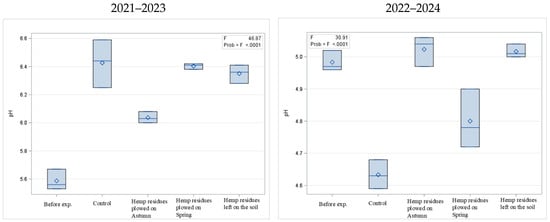
Figure 4.
Soil pH changes before and after hemp residue application for the two experimental periods (2021–2023 and 2022–2024). Data are presented as means ± standard error; p < 0.05 between means, according to Tukey’s HSD test.
3.3. Effect of Hemp Residue Application on Soil Carbon
The results show a significant increase in carbon content when hemp residues were plowed into the soil in early spring. No further significant changes in carbon were found with other treatments (Figure 5). The 2021–2023 results showed that the soil carbon content increased after the experiment in treatments where hemp residues were incorporated in the soil in early spring and hemp residues were left on the soil surface (Figure 5). Furthermore, in the 2022–2024 experiment, the carbon content significantly increased under the same treatment (hemp residue plowed in the spring) (Figure 5). However, weather conditions strongly influenced this outcome, as the unusually dry summers of 2023 and 2024 inhibited residue decomposition. This has likely led to greater carbon accumulation in the soil, possibly due to reduced contact between residues and soil microorganisms, as well as limited decomposition during the winter period, and reduced microbial activity under dry and cold conditions.
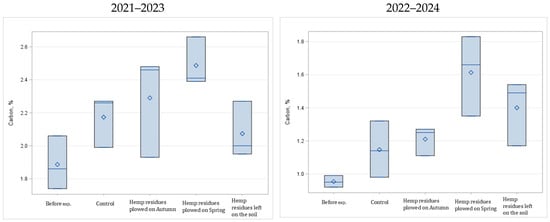
Figure 5.
Changes in soil carbon content before and after hemp residue application for the two experimental periods (2021–2023 and 2022–2024). Data are presented as means ± standard error; p < 0.05 between means, according to Tukey’s HSD test.
The timing of the application was the main factor, as the residues had already slightly decomposed during the winter, and the change in their chemical properties enhanced the soil carbon. Our result aligns with the reported influence of temperature sensitivity on carbon cycling in crop residue decomposition. Warmer seasons accelerate decomposition and carbon release, while winter seasons slow down these processes, promoting longer-term carbon retention [47,51].
3.4. The Effect of Hemp Residue Application on Soil Nitrogen
The nitrogen content before and after the experiments with hemp residue application showed that hemp residues had no significant effect on nitrogen content in the soil for both experimental periods. The application of hemp residue neither significantly decreased nor increased the nitrogen content of the soil (Figure 6). During the 2021–2023 experimental period, the treatment where hemp residues were left on the soil surface showed the lowest nitrogen content compared to the initial levels before treatment. In contrast, during the 2022–2024 period, higher nitrogen contents were observed in the treatments where hemp residues were either plowed into the soil in spring or left on the soil. The nitrogen content of plant residues is considered one of the dominant factors affecting their degradability when acted upon by soil microorganisms [52]. Considering that it is very important to control the nitrogen content of the soil, excessive nitrogen inhibits the growth of the plant’s root system and tillers [26]. Our study showed that hemp residue incorporation could not readily impact N management in the soil. The insignificant change in the soil N content could be attributed to factors such as the high C: N ratio, low N concentrations, and the high lignin and cellulose content of hemp residue [53,54], resulting in a slower decomposition rate and N release. This invariably results in net N immobilization and the prioritization of carbon for their energy needs by the soil microbes. As a result, nitrogen remains locked in organic forms for extended periods, contributing little to immediate changes in the soil nitrogen levels.
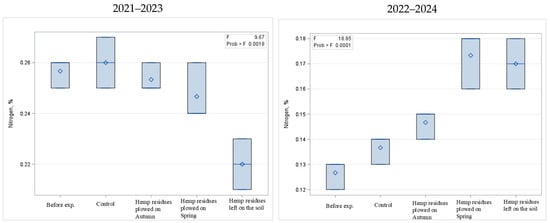
Figure 6.
Nitrogen content in the soil before and after hemp residue application in the soil for the two experimental periods (2021–2023 and 2022–2024). Data are presented as means ± standard error; p < 0.05 between means, according to Tukey’s HSD test.
3.5. The Rate of Hemp Residue Mineralization
The rate of mineralization of plant residues depends strongly on the composition of the plant residues [55]. The higher the lignin and hemicellulose content of the plant residues, the longer the mineralization time [56]. Other important factors of plant residue mineralization include climate conditions, moisture, and the seasonal period [26]. The results of this experiment showed that the mineralization of hemp residue accelerated dramatically after the end of the winter period, with more moisture in the soil and lower temperatures.
In 2021–2022, it was observed that one month (20 November 2021) after applying hemp residues to the soil, the fastest decomposition was recorded in the treatment where the hemp residues had been plowed in autumn. However, there were no statistically significant differences one month after hemp residue application. Furthermore, 4 months (21 April 2022) after the establishment of the hemp residue experiment, the fastest mineralization was recorded in the treatment where the hemp residue was left on the soil surface. This treatment exhibited statistically significant differences from the treatment in which hemp residues were incorporated into the soil in autumn. At the end of the experiment, the fastest mineralization was recorded when hemp residues were incorporated in autumn (Figure 7).
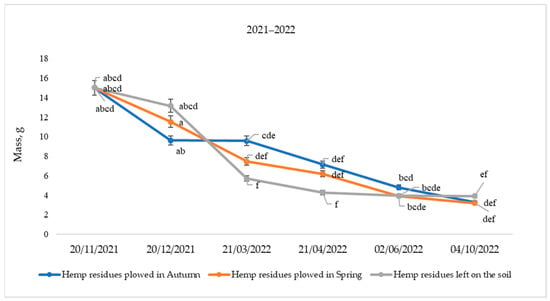
Figure 7.
The rate of hemp residue mineralization in the year 2021–2022. Data are presented as means ± standard error; different letters correspond to significant differences (p < 0.05) between means, according to Tukey’s HSD test.
In 2022–2023, the first month (20/12/2022) after the establishment of the experiment, the results were similar to those observed at the beginning of the experiment in 2021–2022. The highest mineralization rate was found in the treatment where hemp residues were plowed in autumn. In contrast, the lowest mineralization rate occurred when the residues were left on the soil surface. There were, however, no significant differences between these two treatments. Four months (21/04/2022) after the establishment of the experiment, the mineralization of hemp residues was nearly equalized in all the treatments, with no significant differences observed. However, by the end of the experiment, the fastest mineralization was observed in the treatment where hemp residues were plowed in autumn. This treatment was significantly different from the other treatments (Figure 8).
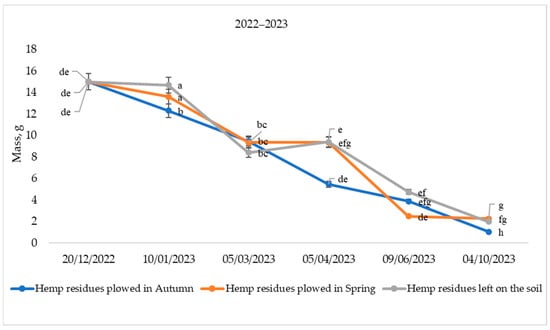
Figure 8.
The rate of hemp residue mineralization in the year 2022–2023. Data are presented as means ± standard error; different letters correspond to significant differences (p < 0.05) between means, according to Tukey’s HSD test.
4. Conclusions
The utilization of hemp residue in agricultural systems represents a promising strategy for enhancing soil health through increased organic matter content, improved nutrient availability, and enhanced carbon content. Although more than 50% of the hemp plant remains as post-harvest residue, its efficient management holds significant potential for these benefits. As hemp residues gradually decompose, they release essential nutrients into the soil, contributing to improved soil chemical properties, reducing reliance on synthetic fertilizers, supporting long-term soil productivity, enhancing carbon sequestration, and advancing sustainable agricultural practices. Specifically, hemp (Cannabis sativa L.) residue positively impacted soil chemical properties concerning carbon content and pH across different plowed timings. The timing of residue application significantly influenced the soil carbon content and pH, though soil nitrogen content remained unaffected. The incorporation of hemp residues into the soil during autumn accelerates decomposition and promotes higher carbon accumulation. Similarly, early spring incorporation enhanced soil carbon content, likely due to pre-decomposition during winter. While slower mineralization and nitrogen immobilization could be a drawback in hemp residue application due to its complex chemical composition and C:N ratio, co-application with nitrogen-rich crop residues or additional nitrogen inputs could set the tone for efficient mineralization and nutrient cycling in the soil. Optimizing hemp residue management to fully harness its benefits in improving soil chemical properties is, therefore, beneficial for soil health and sustainable agriculture.
Author Contributions
Conceptualization, U.M. and V.T.; methodology, U.M.; software, U.M.; validation, U.M., V.T. and M.O.D.; formal analysis, U.M.; investigation, U.M.; resources, V.T. and U.M.; data curation, U.M.; writing—original draft preparation, U.M.; writing—review and editing, V.T. and M.O.D.; visualization, U.M., V.T. and M.O.D.; supervision, V.T. All authors have read and agreed to the published version of the manuscript.
Funding
This research received no external funding.
Data Availability Statement
The original contributions presented in the study are included in the article, further inquiries can be directed to the corresponding author.
Conflicts of Interest
The authors declare no conflicts of interest.
References
- Dudziec, P.; Warmiński, K.; Stolarski, M.J. Industrial Hemp As a Multi-Purpose Crop: Last Achievements and Research in 2018−2023. J. Nat. Fibers 2024, 21, 2369186. [Google Scholar] [CrossRef]
- Visković, J.; Zheljazkov, V.D.; Sikora, V.; Noller, J.; Latković, D.; Ocamb, C.M.; Koren, A. Industrial Hemp (Cannabis sativa L.) Agronomy and Utilization: A Review. Agronomy 2023, 13, 931. [Google Scholar] [CrossRef]
- Sieracka, D.; Frankowski, J.; Wacławek, S.; Czekała, W. Hemp Biomass as a Raw Material for Sustainable Development. Applied Sciences (Switzerland). Multidiscip. Digit. Publ. Inst. 2023, 13, 9733. [Google Scholar]
- Kołodziej, J.; Pudełko, K.; Mańkowski, J. Energy and Biomass Yield of Industrial Hemp (Cannabis sativa L.) as Influenced by Seeding Rate and Harvest Time in Polish Agro-Climatic Conditions. J. Nat. Fibers 2023, 20, 2159609. [Google Scholar] [CrossRef]
- Gill, A.R.; Loveys, B.R.; Cavagnaro, T.R.; Burton, R.A. The potential of industrial hemp (Cannabis sativa L.) as an emerging drought resistant fibre crop. Plant Soil 2023, 493, 7–16. [Google Scholar] [CrossRef]
- Doyeni, M.O.; Suproniene, S.; Barcauskaite, K.; Tilvikiene, V. Geoderma Regional Animal manure digestate fertilization effect on the soil microbial activity and crop productivity in the northern part of temperate climate. Geoderma Reg. 2023, 34, e00699. [Google Scholar] [CrossRef]
- Blanco-Canqui, H.; Shaver, T.M.; Lindquist, J.L.; Shapiro, C.A.; Elmore, R.W.; Francis, C.A.; Hergert, G.W. Cover crops and ecosystem services: Insights from studies in temperate soils. Agron. J. 2015, 107, 2449–2474. [Google Scholar] [CrossRef]
- Seitz, S.; Goebes, P.; Puerta, V.L.; Pereira, E.I.; Wittwer, R.; Six, J.; Van Der Heijden, M.G.; Scholten, T. Conservation tillage and organic farming reduce soil erosion. Agron. Sustain. Dev. 2019, 39, 4. [Google Scholar] [CrossRef]
- Lemtiri, A.; Degrune, F.; Barbieux, S.; Hiel, M.-P.; Chélin, M.; Parvin, N.; Vandenbol, M.; Francis, F.; Colinet, G. Crop residue management in arable cropping systems under temperate climate. Part 1: Soil biological and chemical (phosphorus and nitrogen) properties. A review. BASE 2016, 20, 236–244. [Google Scholar] [CrossRef]
- Pingthaisong, W.; Blagodatsky, S.; Vityakon, P.; Cadisch, G. Mixing plant residues of different quality reduces priming effect and contributes to soil carbon retention. Soil Biol. Biochem. 2024, 188, 109242. [Google Scholar] [CrossRef]
- Alokika; Anu; Singh, B. Utilization of lignocellulosic plant residues for compost formation and its role in improving soil fertility. Pedosphere 2023, 33, 700–716. [Google Scholar] [CrossRef]
- Haas, E.; Carozzi, M.; Massad, R.S.; Butterbach-Bahl, K.; Scheer, C. Long term impact of residue management on soil organic carbon stocks and nitrous oxide emissions from European croplands. Sci. Total Environ. 2022, 836, 154932. [Google Scholar] [CrossRef]
- Piccoli, I.; Sartori, F.; Polese, R.; Berti, A. Crop yield after 5 decades of contrasting residue management. Nutr. Cycl. Agroecosyst. 2020, 117, 231–241. [Google Scholar] [CrossRef]
- Guo, L.; Zheng, S.; Cao, C.; Li, C. Tillage practices and straw-returning methods affect topsoil bacterial community and organic C under a rice-wheat cropping system in central China. Sci. Rep. 2016, 6, 33155. [Google Scholar] [CrossRef]
- Liu, C.; Lu, M.; Cui, J.; Li, B.; Fang, C. Effects of straw carbon input on carbon dynamics in agricultural soils: A meta-analysis. Glob. Change Biol. 2014, 20, 1366–1381. [Google Scholar] [CrossRef]
- Lehtinen, T.; Schlatter, N.; Baumgarten, A.; Bechini, L.; Krüger, J.; Grignani, C.; Zavattaro, L.; Costamagna, C.; Spiegel, H. Effect of crop residue incorporation on soil organic carbon and greenhouse gas emissions in European agricultural soils. Soil Use Manag. 2014, 30, 524–538. [Google Scholar] [CrossRef]
- Xi, H.; Jia, M.; Kuzyakov, Y.; Peng, Z.; Zhang, Y.; Han, J.; Ali, G.; Mao, L.; Zhang, J.; Fan, T.; et al. Key decomposers of straw depending on tillage and fertilization. Agric. Ecosyst. Environ. 2023, 358, 108717. [Google Scholar] [CrossRef]
- Six, J.; Elliott, E.T.; Paustian, K. Soil macroaggregate turnover and microaggregate formation: A mechanism for C sequestration under no-tillage agriculture. Soil Biol. Biochem. 2000, 32, 2099–2103. [Google Scholar] [CrossRef]
- Zhang, X.; Wang, J.; Feng, X.; Yang, H.; Li, Y.; Yakov, K.; Liu, S.; Li, F.M. Effects of tillage on soil organic carbon and crop yield under straw return. Agric. Ecosyst. Environ. 2023, 354, 108543. [Google Scholar] [CrossRef]
- De Los Rios, J.; Poyda, A.; Taube, F.; Kluß, C.; Loges, R.; Reinsch, T. No-Till Mitigates SOC Losses after Grassland Renovation and Conversion to Silage Maize. Agriculture 2022, 12, 1204. [Google Scholar] [CrossRef]
- Schneider, F.; Don, A.; Hennings, I.; Schmittmann, O.; Seidel, S.J. The effect of deep tillage on crop yield—What do we really know? Soil Tillage Res. 2017, 174, 193–204. [Google Scholar] [CrossRef]
- Xue, J.F.; Pu, C.; Liu, S.L.; Chen, Z.D.; Chen, F.; Xiao, X.P.; Lal, R.; Zhang, H.L. Effects of tillage systems on soil organic carbon and total nitrogen in a double paddy cropping system in Southern China. Soil Tillage Res. 2015, 153, 161–168. [Google Scholar] [CrossRef]
- Dong, S.; Ma, Z.; Wang, L.; Yan, C.; Liu, L.; Gong, Z.; Cui, G. Decomposition and nutrient release characteristics of incorporated soybean and maize straw in northeast China. Ekoloji Derg. 2019, 28, 2119–2129. [Google Scholar]
- Gunina, A.; Kuzyakov, Y. From energy to (soil organic) matter. Glob. Change Biol. 2022, 28, 2169–2182. [Google Scholar] [CrossRef] [PubMed]
- Shamshitov, A.; Kadžienė, G.; Pini, F.; Supronienė, S. The role of tillage practices in wheat straw decomposition and shaping the associated microbial communities in Endocalcaric– Epigleyic Cambisol soil. Biol. Fertil. Soils 2024, 61, 211–231. [Google Scholar] [CrossRef]
- Grzyb, A.; Wolna-Maruwka, A.; Niewiadomska, A. Environmental factors affecting the mineralization of crop residues. Agronomy 2020, 10, 1951. [Google Scholar] [CrossRef]
- Tripathi, M.; Sharma, M.; Bala, S.; Connell, J.; Newbold, J.R.; Rees, R.M.; Aminabhavi, T.M.; Thakur, V.K.; Gupta, V.K. Conversion technologies for valorization of hemp lignocellulosic biomass for potential biorefinery applications. Sep. Purif. Technol. 2023, 320, 124018. [Google Scholar] [CrossRef]
- Stulpinaite, U.; Tilvikiene, V. Decomposition of Hemp Residues in Soil as Facilitated by Different Nitrogen Sources. Agriculture 2024, 14, 508. [Google Scholar] [CrossRef]
- Sharma, S.; Kumawat, K.C.; Kaur, P.; Kaur, S.; Gupta, N. Crop residue heterogeneity: Decomposition by potential indigenous ligno-cellulolytic microbes and enzymatic profiling. Curr. Res. Microb. Sci. 2024, 6, 100227. [Google Scholar] [CrossRef]
- Shamshitov, A.; Kadžienė, G.; Supronienė, S. The Role of Soil Microbial Consortia in Sustainable Cereal Crop Residue Management. Plants 2024, 13, 766. [Google Scholar] [CrossRef]
- Huang, T.; Yang, N.; Lu, C.; Qin, X.; Siddique, K.H.M. Soil organic carbon, total nitrogen, available nutrients, and yield under different straw returning methods. Soil Tillage Res. 2021, 214, 105171. [Google Scholar] [CrossRef]
- Jin, Z.; Shah, T.; Zhang, L.; Liu, H.; Peng, S.; Nie, L. Effect of straw returning on soil organic carbon in rice–wheat rotation system: A review. Food Energy Secur. 2020, 9, e200. [Google Scholar] [CrossRef]
- Chen, Z.; Wang, H.; Liu, X.; Zhao, X.; Lu, D.; Zhou, J.; Li, C. Changes in soil microbial community and organic carbon fractions under short-term straw return in a rice–wheat cropping system. Soil Tillage Res. 2017, 165, 121–127. [Google Scholar] [CrossRef]
- Li, H.; Li, J.; Jiao, X.; Jiang, H.; Liu, Y.; Wang, X.; Ma, C. The Fate and Challenges of the Main Nutrients in Returned Straw: A Basic Review. Agronomy 2024, 14, 698. [Google Scholar] [CrossRef]
- Lv, Y.; Wang, Y.; Wang, L.; Zhu, P. Straw return with reduced nitrogen fertilizer maintained maize high yield in Northeast China. Agronomy 2019, 9, 229. [Google Scholar] [CrossRef]
- Li, F.; Liang, X.; Zhang, H.; Tian, G. The influence of no-till coupled with straw return on soil phosphorus speciation in a two-year rice-fallow practice. Soil Tillage Res. 2019, 195, 104389. [Google Scholar] [CrossRef]
- Scheliga, M.; Brand, U.; Türk, O.; Gruber, S.; Medina, L.; Petersen, J. Yield and quality of bast fibre from Abutilon theophrasti (Medic.) in southwest Germany depending on the site and fibre extraction method. Ind. Crops Prod. 2018, 121, 320–327. [Google Scholar] [CrossRef]
- Campiglia, E.; Radicetti, E.; Mancinelli, R. Plant density and nitrogen fertilization affect agronomic performance of industrial hemp (Cannabis sativa L.) in Mediterranean environment. Ind. Crops Prod. 2017, 100, 246–254. [Google Scholar] [CrossRef]
- Svennerstedt, B.; Svensson, G. Hemp (Cannabis sativa L.) trials in southern Sweden 1999–2001. J. Ind. Hemp. 2006, 11, 17–25. [Google Scholar] [CrossRef]
- Ascrizzi, R.; Ceccarini, L.; Tavarini, S.; Flamini, G.; Angelini, L.G. Valorisation of hemp inflorescence after seed harvest: Cultivation site and harvest time influence agronomic characteristics and essential oil yield and composition. Ind. Crops Prod. 2019, 139, 111541. [Google Scholar] [CrossRef]
- Schluttenhofer, C.; Yuan, L. Challenges towards Revitalizing Hemp: A Multifaceted Crop. Trends Plant Sci. 2017, 22, 917–929. [Google Scholar] [CrossRef]
- Žydelis, R.; Herbst, M.; Weihermüller, L.; Ruzgas, R.; Volungevičius, J.; Barčauskaitė, K.; Tilvikienė, V. Yield potential and factor influencing yield gap in industrial hemp cultivation under nemoral climate conditions. Eur. J. Agron. 2022, 139, 126576. [Google Scholar] [CrossRef]
- Bajwa, P.; Singh, S.; Singh, M.; Kafle, A.; Parkash, V.; Saini, R. Assessing the production potential of industrial hemp in the semi-arid west Texas. Technol. Agron. 2023, 3, 17. [Google Scholar] [CrossRef]
- Ning, Q.; Chen, L.; Jia, Z.; Zhang, C.; Ma, D.; Li, F.; Zhang, J.; Li, D.; Han, X.; Cai, Z.; et al. Multiple long-term observations reveal a strategy for soil pH-dependent fertilization and fungal communities in support of agricultural production. Agric. Ecosyst. Environ. 2020, 293, 106837. [Google Scholar] [CrossRef]
- Tang, S.; Zhou, J.; Pan, W.; Tang, R.; Ma, Q.; Xu, M.; Qi, T.; Ma, Z.; Fu, H.; Wu, L. Impact of N application rate on tea (Camellia sinensis) growth and soil bacterial and fungi communities. Plant Soil 2022, 475, 343–359. [Google Scholar] [CrossRef]
- Coulibaly, S.S.; Touré, M.; Kouamé, A.E.; Kambou, I.C.; Soro, S.Y.; Yéo, K.I.; Koné, S. Incorporation of Crop Residues into Soil: A Practice to Improve Soil Chemical Properties. Agric. Sci. 2020, 11, 1186–1198. [Google Scholar] [CrossRef]
- Borkar, P.K.; Sharma, N.; Techtmann, S.; Eisele, T. Pilot plant study on manganese bioleaching using biomass decomposition products as a nutrient source and electrolysis for oxide precipitation. Hydrometallurgy 2025, 232, 106430. [Google Scholar] [CrossRef]
- Wang, R.; Han, Y.; Zhang, T.; Han, Q. Influence of Irrigation and Water Use on the Agronomic Traits of Crops. Agronomy 2025, 15, 224. [Google Scholar] [CrossRef]
- Dhakal, M.; Singh, G.; Cook, R.L.; Sievers, T. Modeling hairy vetch and cereal rye cover crop decomposition and nitrogen release. Agronomy 2020, 10, 701. [Google Scholar] [CrossRef]
- Liu, L.; Ding, M.; Zhou, L.; Chen, Y.; Li, H.; Zhang, F.; Li, G.; Zhou, Z.; Zhang, Y.; Zhou, X. Effects of different rice straw on soil microbial community structure. Agron. J. 2021, 113, 794–805. [Google Scholar] [CrossRef]
- Ghimire, R.; Bista, P.; Machado, S. Long-term Management Effects and Temperature Sensitivity of Soil Organic Carbon in Grassland and Agricultural Soils. Sci. Rep. 2019, 9, 12151. [Google Scholar] [CrossRef] [PubMed]
- Xie, Z.; Yu, Z.; Li, Y.; Wang, G.; Liu, X.; Tang, C.; Lian, T.; Adams, J.; Liu, J.; Liu, J.; et al. Soil microbial metabolism on carbon and nitrogen transformation links the crop-residue contribution to soil organic carbon. NPJ Biofilms Microbiomes 2022, 8, 14. [Google Scholar] [CrossRef] [PubMed]
- Chen, B.; Liu, E.; Tian, Q.; Yan, C.; Zhang, Y. Soil nitrogen dynamics and crop residues. A review. Agron. Sustain. Dev. EDP Sci. 2014, 34, 429–442. [Google Scholar] [CrossRef]
- Stewart, C.E.; Moturi, P.; Follett, R.F.; Halvorson, A.D. Lignin biochemistry and soil N determine crop residue decomposition and soil priming. Biogeochemistry 2015, 124, 335–351. [Google Scholar] [CrossRef]
- Adhikari, A.D.; Shrestha, P.; Ghimire, R.; Liu, Z.; Pollock, D.A.; Acharya, P.; Aryal, D.R. Cover crop residue quality regulates litter decomposition dynamics and soil carbon mineralization kinetics in semi-arid cropping systems. Appl. Soil Ecol. 2024, 193, 105160. [Google Scholar] [CrossRef]
- Weiler, D.A.; Bastos, L.M.; Schirmann, J.; Aita, C.; Giacomini, S.J. Changes in chemical composition of cover crops residue during decomposition. Ciênc. Rural 2022, 52, e20210357. [Google Scholar] [CrossRef]
Disclaimer/Publisher’s Note: The statements, opinions and data contained in all publications are solely those of the individual author(s) and contributor(s) and not of MDPI and/or the editor(s). MDPI and/or the editor(s) disclaim responsibility for any injury to people or property resulting from any ideas, methods, instructions or products referred to in the content. |
© 2025 by the authors. Licensee MDPI, Basel, Switzerland. This article is an open access article distributed under the terms and conditions of the Creative Commons Attribution (CC BY) license (https://creativecommons.org/licenses/by/4.0/).